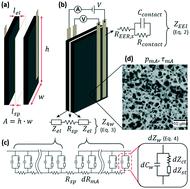当前位置:
X-MOL 学术
›
Environ. Sci.: Water Res. Technol.
›
论文详情
Our official English website, www.x-mol.net, welcomes your
feedback! (Note: you will need to create a separate account there.)
Understanding resistances in capacitive deionization devices
Environmental Science: Water Research & Technology ( IF 3.5 ) Pub Date : 2020-05-14 , DOI: 10.1039/d0ew00169d Helen A. Kuo 1, 2, 3 , Ashwin Ramachandran 3, 4, 5, 6 , Diego I. Oyarzun 1, 2, 3 , Erica C. Clevenger 1, 2, 3 , Juan G. Santiago 3, 5, 6, 7 , Michael Stadermann 1, 2, 3 , Patrick G. Campbell 1, 2, 3 , Steven A. Hawks 1, 2, 3
Environmental Science: Water Research & Technology ( IF 3.5 ) Pub Date : 2020-05-14 , DOI: 10.1039/d0ew00169d Helen A. Kuo 1, 2, 3 , Ashwin Ramachandran 3, 4, 5, 6 , Diego I. Oyarzun 1, 2, 3 , Erica C. Clevenger 1, 2, 3 , Juan G. Santiago 3, 5, 6, 7 , Michael Stadermann 1, 2, 3 , Patrick G. Campbell 1, 2, 3 , Steven A. Hawks 1, 2, 3
Affiliation

|
The desalination characteristics of capacitive deionization (CDI) are significantly impacted by the cell resistance. Here we apply electrochemical impedance spectroscopy (EIS) to analyze the resistive properties of a CDI device, which include EIS measurements on a complete assembled cell (in two wire mode) and EIS measurements with additional contacts to decouple electrode/electrolyte and contact impedances (four wire mode). These measurements shed light on the interface between current collector and electrode as well as the internal capacitive and resistive elements of the cell. With two-wire and four-wire EIS measurements, we find that the often observed high-frequency arc(s) in the impedance spectra can be due to contact effects and/or an internal ionic-transfer resistance that is locally in parallel with macropore wall capacitance. In some cases, the two associated arcs in the Nyquist plot are overlapping and present simultaneously, making their identification in the EIS spectra difficult unless both two-wire and four-wire measurements are made. Despite causing a large high-frequency arc in the Nyquist plot, we find that the apparent internal ionic-transfer resistance is negligible compared to the resistances of the electrode, separator, and external electronic components. An investigation of the contact impedance between the electrode and current collector reveals a parallel RC arc that can grow over time if an improper material is used (e.g., titanium). In our system, the electrode ionic resistance dominates the total Ohmic power dissipation, which has implications for scale-up of CDI systems and future improvements of cell design.
中文翻译:

了解电容去离子设备中的电阻
电容去离子(CDI)的脱盐特性受电池电阻的影响很大。在这里,我们使用电化学阻抗谱(EIS)分析CDI设备的电阻特性,包括在完整的组装电池上以两线模式进行EIS测量,以及通过附加触点使电极/电解质和接触阻抗解耦的EIS测量(四个有线模式)。这些测量结果揭示了集电器和电极之间以及电池内部的电容和电阻元件之间的界面。通过两线和四线EIS测量,我们发现阻抗谱中经常观察到的高频电弧可能是由于接触效应和/或与大孔局部平行的内部离子转移电阻引起的壁电容。在某些情况下,奈奎斯特图中的两个相关电弧是重叠的,并且同时存在,因此除非进行两线和四线测量,否则很难在EIS光谱中进行识别。尽管在奈奎斯特图中会引起大的高频电弧,但我们发现,与电极,隔板和外部电子元件的电阻相比,表观内部离子转移电阻微不足道。对电极和集电器之间的接触阻抗的研究表明,如果使用了不合适的材料,则平行的RC电弧会随着时间的流逝而增大(尽管在奈奎斯特图中会引起大的高频电弧,但我们发现,与电极,隔板和外部电子元件的电阻相比,表观内部离子转移电阻微不足道。对电极和集电器之间的接触阻抗的研究表明,如果使用了不合适的材料,则平行的RC电弧会随着时间的流逝而增大(尽管在奈奎斯特图中会引起大的高频电弧,但我们发现,与电极,隔板和外部电子元件的电阻相比,表观内部离子转移电阻微不足道。对电极和集电器之间的接触阻抗的研究表明,如果使用了不合适的材料,则平行的RC电弧会随着时间的流逝而增大(例如钛)。在我们的系统中,电极的离子电阻支配了总的欧姆功耗,这对CDI系统的规模扩大和电池设计的未来改进有影响。
更新日期:2020-07-02
中文翻译:

了解电容去离子设备中的电阻
电容去离子(CDI)的脱盐特性受电池电阻的影响很大。在这里,我们使用电化学阻抗谱(EIS)分析CDI设备的电阻特性,包括在完整的组装电池上以两线模式进行EIS测量,以及通过附加触点使电极/电解质和接触阻抗解耦的EIS测量(四个有线模式)。这些测量结果揭示了集电器和电极之间以及电池内部的电容和电阻元件之间的界面。通过两线和四线EIS测量,我们发现阻抗谱中经常观察到的高频电弧可能是由于接触效应和/或与大孔局部平行的内部离子转移电阻引起的壁电容。在某些情况下,奈奎斯特图中的两个相关电弧是重叠的,并且同时存在,因此除非进行两线和四线测量,否则很难在EIS光谱中进行识别。尽管在奈奎斯特图中会引起大的高频电弧,但我们发现,与电极,隔板和外部电子元件的电阻相比,表观内部离子转移电阻微不足道。对电极和集电器之间的接触阻抗的研究表明,如果使用了不合适的材料,则平行的RC电弧会随着时间的流逝而增大(尽管在奈奎斯特图中会引起大的高频电弧,但我们发现,与电极,隔板和外部电子元件的电阻相比,表观内部离子转移电阻微不足道。对电极和集电器之间的接触阻抗的研究表明,如果使用了不合适的材料,则平行的RC电弧会随着时间的流逝而增大(尽管在奈奎斯特图中会引起大的高频电弧,但我们发现,与电极,隔板和外部电子元件的电阻相比,表观内部离子转移电阻微不足道。对电极和集电器之间的接触阻抗的研究表明,如果使用了不合适的材料,则平行的RC电弧会随着时间的流逝而增大(例如钛)。在我们的系统中,电极的离子电阻支配了总的欧姆功耗,这对CDI系统的规模扩大和电池设计的未来改进有影响。









































 京公网安备 11010802027423号
京公网安备 11010802027423号